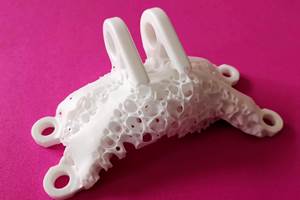Siemens Expands U.S. Additive Manufacturing Initiatives
Company says it is increasing its focus on additive manufacturing research and development to help accelerate transformation of American manufacturing.
Siemens Additive Manufacturing says its technologies help American industry reimagine their products, reinvent their manufacturing and rethink their business. Photo Credit: Siemens
Siemens says it is expanding its focus on additive manufacturing (AM) initiatives in the U.S. to help accelerate the transformation of the U.S. industry through serial additive manufacturing.
“We are on the threshold of a new frontier in American industry, where the implementation of additive manufacturing will bring fundamental changes to the landscape, end-to-end, from product to machine to manufacturing,” says Steve Vosmik, head of Siemens Additive Manufacturing in the U.S. “Siemens is very excited to be at the forefront of this process.”
Siemens is focused on supporting the domestic AM machine builder community, so it is bringing its motion control, automation hardware, digitalization software and technology capabilities to assist machine builders. From its Charlotte Advanced Technology Collaboration Hub (CATCH) in Charlotte, North Carolina, Siemens aims to act as an ecosystem platform for machine builders, machine users and additive design engineers.
“More than 100 machine builders from around the world are implementing Siemens automation solutions to industrialize their machines,” says Rajas Sukthankar, vice-president, motion control, Siemens Industry Inc. “Now it’s time to support even more customers and accelerate their transformation from single machines to series additive manufacturing factories. North America is heading in this direction.”
Siemens says it can assist AM job shops as well as Tier One production facilities with end-to-end solutions, including product design software, digital twin machine simulation and virtual execution of manufacturing methods with full data feedback into the design protocol for necessary adjustments, prior to any machine building. “This comprehensive suite of software and motion control hardware offerings makes Siemens a viable partner at every step of the AM process,” Vosmik adds.
Siemens is adding technology to CATCH to incorporate metal binder jet technology through the purchase and installation of an ExOne/Desktop Metal Production System and Meltio Robotic System with the Siemens Sinumerik RunMyRobot application onboard. Sinumeik RunMyRobot controls the kinematic path of an industrial robot as it integrates with the CNC machine.
Siemens is also establishing an AM Advisory Board of industry leaders, drawn from various industries and technical disciplines, to provide the company guidance as it seeks to support the fast-growing needs of the AM market. “We are looking forward to engaging and collaborating with this talented group of industry experts as we move ahead together into this exciting new world of manufacturing in America,” Vosmik says.
Visit the Siemens Additive Manufacturing website to learn how Siemens is accelerating transformation in the manufacturing industry.
- Read about how Senvol is commercializing Siemens Energy’s material databases for Ti64, Inconel 625 and Inconel 718 for use on laser powder bed fusion machines. Although the data was initially intended exclusively for internal use, the company recently decided to make the data commercially available.
- Learn how HP says it is pushing the limits of workflow automation on the AM factory floor by working closely with long-standing partner Siemens on a proof-of-concept demonstration.
- Check out this article on a 3D printed heat exchanger that illustrates Siemens’ CATCH and release approach. The solutions for energy efficiency, sustainability, part repair and more are developing at Siemens’ Charlotte Advanced Technology Collaboration Hub (CATCH) in North Carolina.
Related Content
Additive Manufacturing Production at Scale Reveals the Technology's Next Challenges: AM Radio #28
Seemingly small issues in 3D printing are becoming larger problems that need solutions as manufacturers advance into ongoing production and higher quantities with AM. Stephanie Hendrixson and Peter Zelinski discuss 6 of these challenges on AM Radio.
Read MoreSpherene Creates Metamaterial with Geometry Derived from Spheres
An algorithm developed by Spherene Inc. generates Adaptive Density Minimal Surfaces (ADMS) as a self-supporting infill strategy that can be used to reduce mass and manage material properties in 3D printed parts.
Read More3D Printed "Evolved Structures" for NASA Exoplanet Balloon Mission: The Cool Parts Show #61
Generative design creates stiff, lightweight brackets for EXCITE mission monitoring planets orbiting other stars. The Cool Parts Show visits Goddard Space Flight Center.
Read MoreSolving 3D Printing’s Hidden Problem: Vibration
Ulendo’s vibration compensation software can double the speed of FFF 3D printers while maintaining part quality, all without changing the machine’s hardware.
Read MoreRead Next
Hybrid Additive Manufacturing Machine Tools Continue to Make Gains (Includes Video)
The hybrid machine tool is an idea that continues to advance. Two important developments of recent years expand the possibilities for this platform.
Read More3D Printing Brings Sustainability, Accessibility to Glass Manufacturing
Australian startup Maple Glass Printing has developed a process for extruding glass into artwork, lab implements and architectural elements. Along the way, the company has also found more efficient ways of recycling this material.
Read More4 Ways the Education and Training Challenge Is Different for Additive Manufacturing
The advance of additive manufacturing means we need more professionals educated in AM technology.
Read More






















